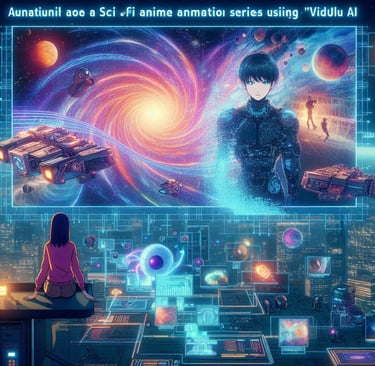AI-Generated Sci-Fi: Aura Productions and Vidu Signal a Turning Point for Animated Content
Aura Productions is launching a sci-fi anime series entirely generated using Vidu, a Chinese AI video tool designed for consistent character and scene animation. The project showcases how AI can enhance storytelling by enabling small teams to create high-quality, serialized content for social media. This collaboration signals a shift in animation, blending traditional principles with AI to empower a new generation of hybrid creators.
TOOLS
The AI Maker
7/31/20252 min read


The promise of AI-generated video has long sparked excitement, skepticism, and viral flops in equal measure. But a new partnership between Aura Productions and ShengShu Technology’s Vidu may mark a turning point in the journey from novelty to narrative. With the upcoming launch of a short-form sci-fi anime series built entirely using generative AI, Aura and Vidu are setting out to prove that consistency, storytelling, and creativity can coexist—even thrive—within an AI-first production pipeline.
At the heart of this endeavor is Vidu, an emerging Chinese competitor to video generation models like OpenAI’s Sora. While previous AI-generated films have been clunky, chaotic, or just plain unwatchable, Aura’s use of Vidu’s Multiple-Entity Consistency feature represents a technological leap. This functionality enables characters, settings, and objects to persist reliably across scenes—a problem that has plagued most generative models to date.
Aura’s founders, D.T. Carpenter and Luo Yan, are embracing the AI-first workflow to create a 50-episode micro-series, each only one to two minutes in length. While the brevity might seem limiting, Carpenter argues it’s an intentional design for the fast-paced world of social media content. In his view, combining traditional animation sensibilities with the speed and scale of AI allows for creative fidelity without bloated production cycles.
Vidu’s head, Evan Liao, further explained the technical challenges: whereas traditional animation ensures consistency through painstaking frame-by-frame edits, AI models often falter when managing multiple characters or scenes. Vidu’s solution is a sophisticated consistency engine that helps maintain visual coherence—a crucial need for serialized storytelling.
Aura’s approach is not hybrid; it’s AI-first. However, that doesn’t mean human creativity is absent. Instead, it reflects a broader trend emerging across the animation industry: the rise of a new kind of creator—someone who understands both the fundamentals of animation and the mechanics of AI. This vision echoes other ambitious projects like Fable Studios’ Showrunner, which aims to offer “choose-your-own-adventure” style AI video creation. Whether these efforts can resonate emotionally with viewers is still an open question, especially considering the mixed reception of early AI-generated content like the Coca-Cola Christmas ad and Volvo’s AI experiment.
But Aura and Vidu are betting big that the tide is turning. Their collaboration isn’t just about producing a quirky proof of concept—it’s about making something people actually want to watch. The team’s optimism rests not on replacing animators, but augmenting them, expanding what small studios can accomplish with fewer resources.
If successful, this project may not just validate AI’s role in visual storytelling—it may help define it. Whether audiences embrace AI-generated anime with the same fervor as traditional series remains to be seen. But one thing is clear: animation’s future won’t be purely hand-drawn or entirely synthetic. It will be something new—and it may just start here.
Your Data, Your Insights
Unlock the power of your data effortlessly. Update it continuously. Automatically.
Answers
Sign up NOW
info at aimaker.com
© 2024. All rights reserved. Terms and Conditions | Privacy Policy
